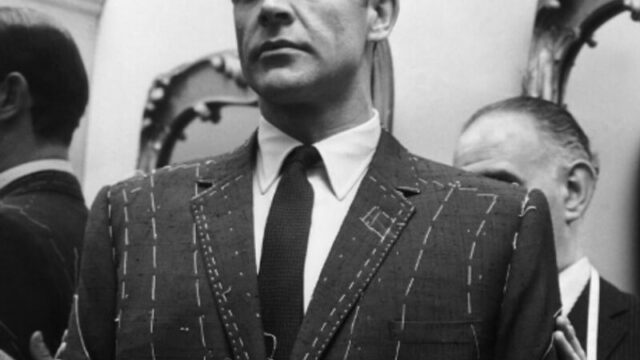Revolt of the Dandies

The decline of Western culture is most easily perceived not in our galleries and museums, or even on our stages and screens, but in the wardrobes of American men and women. Stroll the main streets of our cities. Is this really how the citizens of the most powerful nation in the world should look?
Both the working and professional classes alike go about their days attired for maximum comfort: there is little clear sense of self-presentation. The heirs of our empire shuffle across campus in pajamas and slippers. When not in “athleisure,” our titans of capitalism favor cozy sweaters and forgiving trousers – coats and ties are for congressional subpoenas. Along the corporate ladder, it’s denim and synthetic fleece all the way down.
Almost two decades ago, Michael Anton’s alter-ego Nicholas Antongiavanni lamented “an America that is shabbier than the English, haughtier than the French, more fashion-enthralled than the Italians, without style, without class, shoddy, garish, unkempt, vulgar, and enduring blemishes of every sort.”
The cultural situation today is, if anything, worse. But how did we get here? A number of authors recently offered their diagnoses for the Claremont Institute’s journal The American Mind. Writing of the absence of right-wing culture more generally, they pointed to an absence of aesthetic education for the young, a loss of cultural intermediaries “between talent and money,” and an agenda that places special interests above financial success.
Whether out of practicality or experience, these approaches all take a market-based approach and assume that the market will appreciate art or that a market can be created for art appreciation. They don’t seem to recognize that this cultural decline is built into the logic of capitalism, whose profit-maximizing telos aims at industrial production and mass consumption.
We don’t just have a problem in mass culture. We lack a cultural elite to define a united Western style for our moment in history. We have a civilizational crisis of taste. Bipartisan and systemic, it touches not only the intermediaries but the talent and money as well – proletariat, middle-class, and elites.
Consider one flagrant example. A year and a half ago, then Senate Majority Leader Chuck Schumer willfully abolished the longstanding dress code to allow Senator John Fetterman to vote from the Senate floor wearing his gym clothes. Fetterman described his own sartorial sloth as a “Burger King ‘You Rule’ kind of a thing.” Although the dress code was reinstated, the action struck one more blow to our federal government’s frail legitimacy.
The follow-on punch arrived with Elon Musk’s appearances in the White House wearing a T-shirt, jeans, and a baseball cap. Musk’s sloppy attire negatively affected the domestic and international perception of DOGE’s admirable mission to eliminate waste and hold the government accountable. Ukraine’s Zelensky was rightly harangued for showing up to the White House in a sweatsuit. Shouldn’t Musk, as DOGE director and the world’s richest man, have done better?

Against this slovenly backdrop, however, in recent years, I began to notice a growing number of young men interested not only in the self-improvement of well-made beds and better diets, but in dressing as the incarnation of a philosophical mindset. In most cases, this hasn’t been passed from father to son, but skipped a generation: the memory of a debonair grandfather or relative lit the spark.
In the midst of this aesthetic desert, these young men have re-discovered the struggle for distinction and the joy of dressing. The best word to describe them is one that has mostly flown from our lexicons: dandies.
Contrary to widespread misconception, the dandy is neither a fop nor an aesthete: he is a priest of elegance, enemy of triviality, aristocrat of the spirit, disciple of virtù. Anton, a paradigm of style, says the dandy “favors simple clothes, pristine in cut, immaculate in fit, made from resilient materials by expert craftsmen, never ostentatious, always manly.”
If we want to influence culture in the newly proclaimed Golden Age, conservatism must overcome its opposition to style in dressing, writing, and living. As Tom Wolfe wrote of architecture, the austerity fetish belongs to socialism. C. S. Lewis, for his part, observed that “naked” derives from the obsolete verb “to nake,” meaning to peel, and therefore “the naked man has seemed to our ancestors not the natural but the abnormal man […] In that way, we are ‘more ourselves’ when clothed.” Lewis is talking about style – the sense that the way we live isn’t neutral and can help us become who we are – and that’s something the Right should embrace.
Alongside decadent culture and conservative skepticism, the government-university-media complex – the famous “Cathedral” – actively assails young men, nudging them into conformist slobbery. The dogma of “inclusion” militates for “affirmation” at all costs. The legalization of stupefacients encourages hedonist apathy. The “body positivity” movement normalizes obesity. Within government, the Biden FBI compiled glossaries of terms indicating potential for violent extremism that include “based,” “LARPing,” “Red Pill,” and “looksmaxxing,”– a combination of exercise, skincare, and grooming – which they define as “the process of self-improvement with the intent to become more attractive.” Despite the re-election of Donald Trump, the Cathedral still labors to make young men fat, ugly, and weak. It has to be stopped.
The return of the dandy at this hour shouldn’t surprise us. Writing three decades after Alexis de Tocqueville published Democracy in America, the critic and poet Charles Baudelaire proclaimed that “dandyism appears above all in transitional periods, when democracy is not yet all-powerful, and aristocracy is but partly unstable and debased.” Rather than a symptom of decadence, it is “the last burst of heroism” in the midst of cultural decline. One-and-a-half centuries later, our dandy revolts against the systemic mediocrity of our age and, as in Baudelaire’s time, may even aim to establish “a new kind of aristocracy.”
“Dandyism is a setting sun,” wrote Baudelaire, eyeing “the rising tide of democracy, which overruns and flattens everything.” In the intervening time, history and regimes have oscillated such that our dandysme hails a rising sun. This growing brigade of young men is an additional cause for hope, from whose number may come new arbiters of style, new aesthetic law-givers. Since “manners of dress […] are an outward sign of our inward spirit,” we ought not expect them to seek internet fame, social media monetization, opportunities for self-promotion, or other market-based metrics of status. Yet they should be recognized and their style held up to the nation.
In their pursuit of excellence, our dandies may be maligned for tarrying with the surface of things, yet in doing so, they have grasped both our crisis and the means to restore our civilization.
